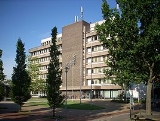
Sehnde
Encyclopedia
Sehnde is a town
in Lower Saxony
, Germany
. It is located approx. 15 kilometres southeast of Hanover
.
The whole area was agricultural
for centuries, until large salt
and potash
deposits were discovered at the end of the 19th century. Several potash mines
were dug, the first at Gustavshall in Hohenfels
in 1896. During the 20th century, Sehnde and Ilten were the chief beneficiaries of the mines, until the last one was closed in 1995. Since the 1950s, most of the area has been transformed into dormitory villages, while jobs have concentrated in Hannover. In 2005, small one-family houses dominate large parts of Sehnde and its villages.
museum, the Hannoversches Straßenbahn-Museum
.
Town
A town is a human settlement larger than a village but smaller than a city. The size a settlement must be in order to be called a "town" varies considerably in different parts of the world, so that, for example, many American "small towns" seem to British people to be no more than villages, while...
in Lower Saxony
Lower Saxony
Lower Saxony is a German state situated in north-western Germany and is second in area and fourth in population among the sixteen states of Germany...
, Germany
Germany
Germany , officially the Federal Republic of Germany , is a federal parliamentary republic in Europe. The country consists of 16 states while the capital and largest city is Berlin. Germany covers an area of 357,021 km2 and has a largely temperate seasonal climate...
. It is located approx. 15 kilometres southeast of Hanover
Hanover
Hanover or Hannover, on the river Leine, is the capital of the federal state of Lower Saxony , Germany and was once by personal union the family seat of the Hanoverian Kings of Great Britain, under their title as the dukes of Brunswick-Lüneburg...
.
History
Sehnde was formed in 1974 by combining fifteen autonomous villages which belonged to three different districts: Bilm, Bolzum, Dolgen, Evern, Gretenberg, Haimar, Hoever, Ilten, Klein Lobke, Müllingen, Rethmar, Sehnde, Wassel, Wehmingen, and Wirringen. Sehnde received its town charter in 1997.The whole area was agricultural
Agriculture
Agriculture is the cultivation of animals, plants, fungi and other life forms for food, fiber, and other products used to sustain life. Agriculture was the key implement in the rise of sedentary human civilization, whereby farming of domesticated species created food surpluses that nurtured the...
for centuries, until large salt
Salt
In chemistry, salts are ionic compounds that result from the neutralization reaction of an acid and a base. They are composed of cations and anions so that the product is electrically neutral...
and potash
Potash
Potash is the common name for various mined and manufactured salts that contain potassium in water-soluble form. In some rare cases, potash can be formed with traces of organic materials such as plant remains, and this was the major historical source for it before the industrial era...
deposits were discovered at the end of the 19th century. Several potash mines
Mining
Mining is the extraction of valuable minerals or other geological materials from the earth, from an ore body, vein or seam. The term also includes the removal of soil. Materials recovered by mining include base metals, precious metals, iron, uranium, coal, diamonds, limestone, oil shale, rock...
were dug, the first at Gustavshall in Hohenfels
Hohenfels
Hohenfels is a municipality in the district of Konstanz in Baden-Württemberg in Germany....
in 1896. During the 20th century, Sehnde and Ilten were the chief beneficiaries of the mines, until the last one was closed in 1995. Since the 1950s, most of the area has been transformed into dormitory villages, while jobs have concentrated in Hannover. In 2005, small one-family houses dominate large parts of Sehnde and its villages.
Culture
The former potash mine Hohenfels in Wehmingen houses the national German tramwayRail transport
Rail transport is a means of conveyance of passengers and goods by way of wheeled vehicles running on rail tracks. In contrast to road transport, where vehicles merely run on a prepared surface, rail vehicles are also directionally guided by the tracks they run on...
museum, the Hannoversches Straßenbahn-Museum
Hannoversches Straßenbahn-Museum
The Hannoversches Strassenbahn-Museum or Hanover Tramway Museum comprises a collection of tramcars from all over Germany, and is located on the site of a former potash mine in Sehnde, southeast of the city of Hanover.- External links :**...
.

